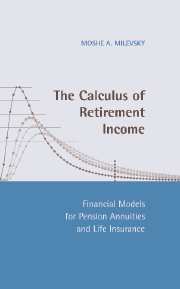Book contents
- Frontmatter
- Contents
- List of Figures and Tables
- I MODELS OF ACTUARIAL FINANCE
- 1 Introduction and Motivation
- 2 Modeling the Human Life Cycle
- 3 Models of Human Mortality
- 4 Valuation Models of Deterministic Interest
- 5 Models of Risky Financial Investments
- 6 Models of Pension Life Annuities
- 7 Models of Life Insurance
- 8 Models of DB vs. DC Pensions
- II WEALTH MANAGEMENT: APPLICATIONS AND IMPLICATIONS
- III ADVANCED TOPICS
- Bibliography
- Index
5 - Models of Risky Financial Investments
from I - MODELS OF ACTUARIAL FINANCE
Published online by Cambridge University Press: 06 July 2010
- Frontmatter
- Contents
- List of Figures and Tables
- I MODELS OF ACTUARIAL FINANCE
- 1 Introduction and Motivation
- 2 Modeling the Human Life Cycle
- 3 Models of Human Mortality
- 4 Valuation Models of Deterministic Interest
- 5 Models of Risky Financial Investments
- 6 Models of Pension Life Annuities
- 7 Models of Life Insurance
- 8 Models of DB vs. DC Pensions
- II WEALTH MANAGEMENT: APPLICATIONS AND IMPLICATIONS
- III ADVANCED TOPICS
- Bibliography
- Index
Summary
Recent Stock Market History
In this chapter I will introduce models for investments that are more risky than the relatively safe fixed-income bonds introduced in the previous chapter. My objective is to develop a limited set of formulas for computing the probabilities of various investment outcomes over long-term horizons.
Table 5.1 starts us down this path by providing a 10-year history of the stock market as proxied by the widely cited Standard & Poor's index of the 500 largest companies traded in the United States. I will label this the SP500 index, or sometimes just “the index.” Although this index captures only 500 of more than 5,000 investable stocks and common shares in the United States, these 500 are quite influential because they account for roughly 60%–70% of the market capitalization (i.e., the market value of all companies) in the country.
Of course, many other developed countries have their own stock market and indices—and the financial models we develop can be applied to any one of them—but I have selected the U.S. market because of its overwhelming influence in the global economy.
For example, if at the open of trading in January 1995 you invested $100 spread amongst these 500 companies—or if you purchased $100 of an open-ended mutual fund or exchange-traded mutual fund that invested in the SP500 index—then at the close of trading in December 1995 your money would have grown to 100(1 + 0.3743) = 137.43 dollars.
- Type
- Chapter
- Information
- The Calculus of Retirement IncomeFinancial Models for Pension Annuities and Life Insurance, pp. 83 - 109Publisher: Cambridge University PressPrint publication year: 2006



